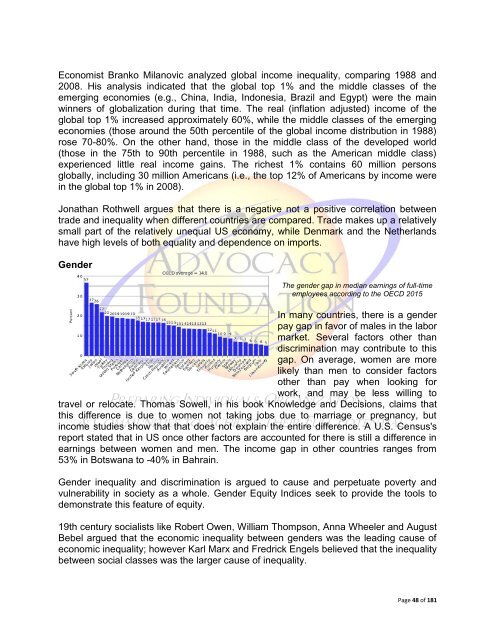Create successful ePaper yourself
Turn your PDF publications into a flip-book with our unique Google optimized e-Paper software.
Economist Branko Milanovic analyzed global income inequality, comparing 1988 and<br />
2008. His analysis indicated that the global top 1% and the middle classes of the<br />
emerging economies (e.g., China, India, Indonesia, Brazil and Egypt) were the main<br />
winners of globalization during that time. The real (inflation adjusted) income of the<br />
global top 1% increased approximately 60%, while the middle classes of the emerging<br />
economies (those around the 50th percentile of the global income distribution in 1988)<br />
rose 70-80%. On the other hand, those in the middle class of the developed world<br />
(those in the 75th to 90th percentile in 1988, such as the American middle class)<br />
experienced little real income gains. The richest 1% contains 60 million persons<br />
globally, including 30 million Americans (i.e., the top 12% of Americans by income were<br />
in the global top 1% in 2008).<br />
Jonathan Rothwell argues that there is a negative not a positive correlation between<br />
trade and inequality when different countries are compared. Trade makes up a relatively<br />
small part of the relatively unequal US economy, while Denmark and the Netherlands<br />
have high levels of both equality and dependence on imports.<br />
Gender<br />
The gender gap in median earnings of full-time<br />
employees according to the OECD 2015<br />
In many countries, there is a gender<br />
pay gap in favor of males in the labor<br />
market. Several factors other than<br />
discrimination may contribute to this<br />
gap. On average, women are more<br />
likely than men to consider factors<br />
other than pay when looking for<br />
work, and may be less willing to<br />
travel or relocate. Thomas Sowell, in his book Knowledge and Decisions, claims that<br />
this difference is due to women not taking jobs due to marriage or pregnancy, but<br />
income studies show that that does not explain the entire difference. A U.S. Census's<br />
report stated that in US once other factors are accounted for there is still a difference in<br />
earnings between women and men. The income gap in other countries ranges from<br />
53% in Botswana to -40% in Bahrain.<br />
Gender inequality and discrimination is argued to cause and perpetuate poverty and<br />
vulnerability in society as a whole. Gender Equity Indices seek to provide the tools to<br />
demonstrate this feature of equity.<br />
19th century socialists like Robert Owen, William Thompson, Anna Wheeler and August<br />
Bebel argued that the economic inequality between genders was the leading cause of<br />
economic inequality; however Karl Marx and Fredrick Engels believed that the inequality<br />
between social classes was the larger cause of inequality.<br />
Page 48 of 181

















